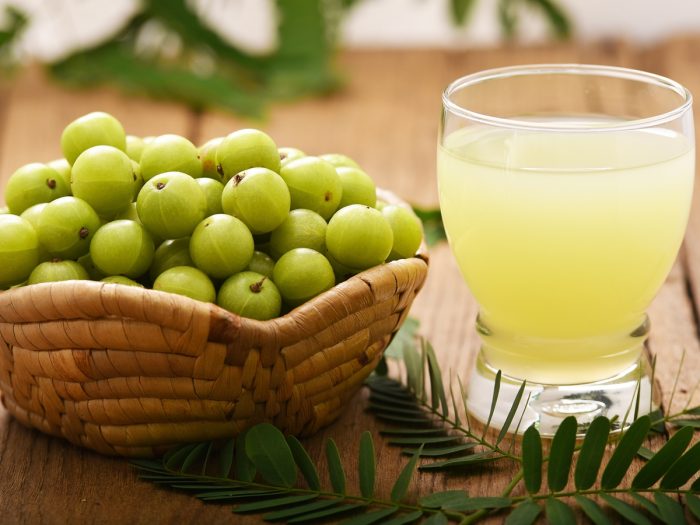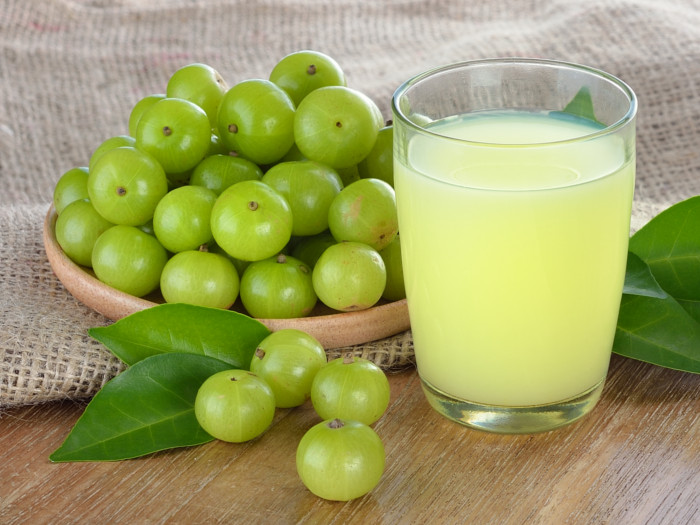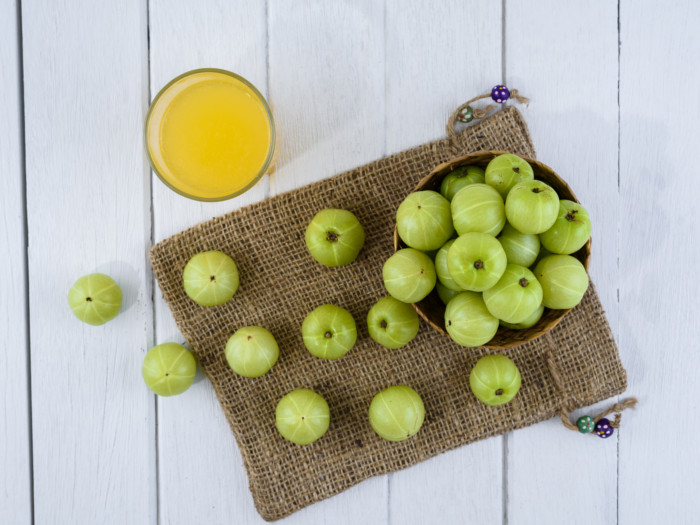Ever heard of amla juice? If you haven’t, then take note, as it has a host of excellent health benefits. The most notable benefits of amla juice may include treating cough and cold, helping to lower cholesterol levels, regulating blood sugar levels, optimizing digestion, and treating respiratory infections. It may also minimize signs of aging, prevents chronic disease, stimulates the immune system, and promotes growth and development, among others.
What is Amla Juice?
Amla juice is the juice of the amla berry, often referred to as Indian gooseberry. Scientifically known as Phyllanthus emblica, this tree bears the amla berries, which are pale green and translucent. The amla berry has been used in culinary and medicinal applications for thousands of years. However, the taste of the berry is quite bitter, which is why its use as a fruit juice may not be readily apparent. However, given the incredible range of nutrients and antioxidants found in amla juice, it is increasing in popularity.
Amla juice possesses high levels of vitamin C and other antioxidants that can be found in the form of oil, tea, powder, capsules, and spice. It is a rich source of other active ingredients including ellagitannins, flavonoids, kaempferol, and gallic acid, all of which can have extensive impacts on human health.
Health Benefits of Amla Juice
Let’s have a look at the most important health benefits of amla juice in detail:
May Treat Cold and Cough
Given its possibly high levels of vitamin C and other antioxidants, as mentioned, amla juice can help treat cough, cold, flu, and even mouth ulcers. Mix two teaspoons of amla juice with an equal amount of honey, and consume it to get rid of a cough and cold more quickly. For mouth ulcers, mix 2 teaspoons with water, and gargle twice a day.

Basket of amlas Photo Credit: Shutterstock
May Lower Cholesterol Levels
A study published in the Journal of Ethnopharmacology shows that cholesterol levels can be lowered effectively by the regular consumption of amla juice. In fact, it is now being incorporated into more treatment strategies due to its possibly high levels of key antioxidants. This study focused on lipid levels in an animal population, so further research is needed, however, these findings are promising! [1]
May Control Diabetes
In reasonable quantities, amla juice may have the ability to provide energy while also regulating blood glucose levels, which can help diabetics control their blood sugar levels and prevent dangerous drops and spikes. A research study published in the International Journal of Food Sciences and Nutrition shows the favorable results that amla juice can have.
May Improve Respiratory Health
Intake of amla juice has historically been used to improve respiratory health such as asthma. Why? It is known to soothe inflammation and address underlying infections in your respiratory tracts. [2]
May Aid in Digestion
The fiber present in amla juice helps boost your digestive health. While too much will cause constipation, a moderate amount of this juice can cut down on gastric inflammation and stimulate normal bowel movements. [3]
May Slow Down the Appearance of Aging
As a juice touted as containing more antioxidants than any other fruit or vegetable, amla juice can help prevent the signs of aging and improve the appearance of the skin. The activity of antioxidants may eliminate free radicals and prevents cellular mutation, including those that cause loose skin. [4]
May Aid in Skin Care
Vitamin C, which is known to be present in high amounts in amla juice, is a necessary component of collagen. Collagen is known to be the most plentiful protein in the body and is a big component of the body’s tendons, ligaments, skin, and muscles. [5]
May Improve Heart Health
Numerous studies have been conducted on amla juice and its potential role in lowering blood pressure. The possible presence of potassium may also help this drink reduce tension in the blood vessels and arteries, thus reducing chronic conditions such as atherosclerosis, heart attacks, and strokes. [6]
May Boost Immunity
Amla juice is rich in vitamin C, as mentioned. This can boost your immune system and possibly increase your production of white blood cells, per a research study conducted through the Indian Agricultural Research Institute in India. [7]
Amla Juice for Nourishing Hair
Interestingly enough, amla juice can be useful for hair health in many different ways. It can be both consumed and topically applied. Drinking it may supply minerals, antioxidants, and nutrients that may promote the well-being of hair. However, if you topically apply this juice to your scalp, you can also help soothe inflammation, stimulate the health of hair follicles, and prevent dandruff. Finally, many people choose to mix amla juice with their hair products or organic hair washes, as it can help to improve shine and luster, particularly for those with brittle hair or split ends. [8]
Amla Juice for Aiding in Weight Loss
Amla juice has known to be used as a possible weight-loss supplement, primarily because it has very few calories but high levels of vitamin C and omega 3 fatty acids. This can help increase energy without increasing calorie or fat levels. It also contains antioxidants and polyphenols associated with enhancing metabolism, which may assist with passive fat burning.
How to Make Amla Juice?
While amla juice is easily available in the market, it’s fairly easy to prepare it at home. You can extract 70% of juice from the fruit. Hence, to make a quart of juice, you will need around 3 pounds of amla (45-50 fruits). So, let’s get on with the recipe, shall we?

Nutrient-Rich Amla Juice Recipe
Ingredients
- 45-50 amlas
- sugar/honey as per taste
- rock salt as per taste
Instructions
- Wash the amla/gooseberries under running water to remove any contaminants. Discard any gooseberry which is soft to touch or has bruises and dark spots.
- Cut the fruits into half and remove the large seeds. Gooseberries or amlas are fibrous and will require a sharp-edged knife.
- Put the amla pieces into a blender and pulse until you get a smooth texture.
- Strain the amla juice through a cheesecloth or a fine strainer to extract as much juice as possible.
- Enjoy a glass of juice with sugar, rock salt, or honey as per your taste!

Notes
- While drinking fresh amla juice daily is considered the healthiest option, it may be too bitter to taste. The juice is best when mixed with other sour or tart juices such as lemon and honey, jamun (Indian blackberry), bitter gourd, or aloe vera. These can help mask the bitterness of the fruit.
- You could also use amla fruit or its pulp to prepare jams, spreads, murabba, chutneys, and pickles.
Amla Juice on an Empty Stomach
Drinking amla juice on an empty stomach first thing in the morning ensures the absorption of all nutrients. It can work as an excellent energy boost at the start of the day or as a soothing beverage that will help your body digest and repair more efficiently while you sleep.
Side Effects
As with any extremely powerful health food, there can also be some severe side effects if you drink too much, including constipation, hypoglycemia, dry skin, hypotension, acid reflux, and allergic reactions.
- Constipation: Even though amla juice helps to strengthen the digestive system, excess intake may cause constipation.
- Dry Skin: The diuretic nature of amla juice is excellent for detoxifying the body, but it can lead to dehydration, which will show itself on your skin. Be sure to drink enough water in conjunction with amla juice.
- Blood Pressure: The ability of amla juice to lower blood pressure can be dangerous when combined with blood pressure medication, so speak with a doctor before adding this juice to your diet.
- Blood Sugar: Similarly, this juice is praised for regulating blood sugar. However, there is a risk for hypoglycemia – low blood sugar – which is dangerous for both normal people and diabetics alike.
- Allergic Reactions: Some people are allergic to this fruit. Side effects include stomach upset, nausea, diarrhea or vomiting, or swelling of the lips, tongue, or throat. Discontinue its use immediately if these symptoms appear.

